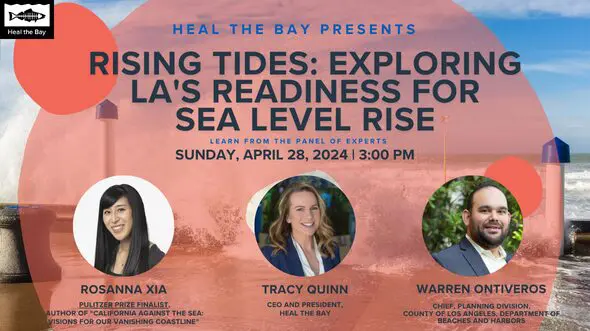Street Wisdom From Our New CEO
Ruskin Hartley, Heal the Bay’s newly appointed CEO, makes some sweeping comments about L.A. in his inaugural post for his On the Watershed blog.
It’s Wednesday and that means I need to move my car parked in Santa Monica from the north side of the street between the hours of noon and 3 p.m. If I remember, the street sweeper can work its magic. If I forget, I risk a fine. That had me thinking of watersheds. Bear with me.
The concept of a watershed is pretty simple — it’s an area of land where all water falling within it drains to a common point. It’s also the name given to the boundary demarcating this area. Whether we know it or not, we all live within a watershed. Healthy watersheds provide a home for countless creatures and give us clean water. Start to mess with a watershed — by building in it, damming it, logging it, mining or drilling in it — and you start to impair the health of the watershed and the quality of its water. Unfortunately many watersheds around the world are suffering today. And in turn, so does anything that lives there — including us.
It’s hard to image that a heavily urbanized area is also a watershed. Fly over L.A. and all you see are buildings as far as the eye can see. To me, it couldn’t get more different from northern California and its thick blanket of forest. But both are watersheds and both suffer from degradation that affects the health of the watershed and the quality of its water. In turn, poor water quality and degraded watersheds struggle to support life and provide us with clean, drinkable, swimable water.
In northern California, rural roads that dump sediment into creeks and a legacy of aggressive logging are obvious signs of an impaired watershed. Millions are being spent fixing these problems so salmon and other animals can once again thrive. Down here in Los Angeles, it’s different. I now live in a highly urbanized environment where I almost never see a creek, let alone a fish swimming in it.
For 28 years, Heal the Bay has led the charge to clean up Santa Monica bay and its watersheds. At first our founders had to tackle the acute problems, such as the dumping of partially treated wastewater into the Bay that was killing sea life and sickening surfers. Today, the challenges are more those of a chronic malaise. We’ve triaged the worst of it, and now we have to deal with the underlying causes. Foremost is how we deal with stormwater that flushes directly from the street to the bay, untreated, carrying the toxic debris of urban life with it.
Because in most regions all water flows to the ocean, the health of the bay is an indicator of the health of the region and its watersheds. When we can swim in the bay 365 days a year and know that it provides a rich environment for the countless sea life beneath the waves, we know we’re doing our job. While huge strides have been made over the past 28 years, there’s a long way to go to complete the task of healing Santa Monica bay.
And that brings me back to street sweeping. Moving your car once a week is a simple act that helps keep the watershed just that little bit healthier. Every bit of trash swept up is one less piece that is dumped in the bay. And what’s true here, is also true in your neighborhood. As all oceans are really just one body of water, so we all live in the same watershed. And to me that’s a powerful thought as I move my car and help protect the ocean along the way.
To read more about Ruskin’s thoughts about sustainability and his journeys through the natural world, please visit RuskinHartley.com



